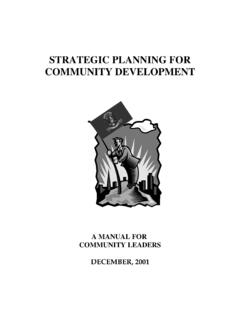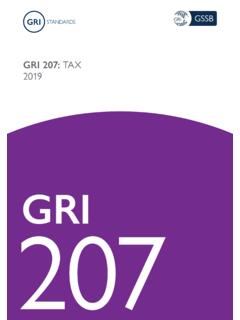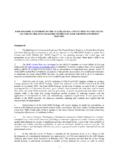Transcription of MANAGING AND IMPROVING TAX COMPLIANCE SEPT 04
1 ORGANISATION FOR ECONOMIC CO-OPERATION AND DEVELOPMENT GUIDANCE NOTE COMPLIANCE Risk Management: MANAGING and IMPROVING Tax COMPLIANCE Prepared by Approved by Forum on Tax Administration Committee on Fiscal Affairs COMPLIANCE Sub-group October 2004 CENTRE FOR TAX POLICY AND ADMINISTRATION MANAGING and IMPROVING Tax COMPLIANCE 2 TABLE OF CONTENTS ABOUT THIS 5 Inquiries and further SUMMARY .. 7 INTRODUCTION ..8 MANAGING and IMPROVING 8 Monitoring COMPLIANCE in four domains .. 8 Pursuing a risk management approach ..9 Introducing the COMPLIANCE risk management process ..9 Changing environments demand new treatment approaches .. 10 Focusing on small business.
2 11 Providing a snapshot of current practice ..11 1 ESTABLISHING THE CONTEXT .. 12 Recognising the operating context .. 12 Focusing on COMPLIANCE risks .. 13 Monitoring the external 13 Shaping internal capability ..14 2 IDENTIFYING RISKS .. 17 Starting with the big 17 Identifying strategic and operational risks .. 17 Narrowing the perspective ..19 Segmenting the market ..20 Recognising a continuum of risk .. 21 Using relevant indicators to identify Evaluating success in identifying 3 ASSESSING AND PRIORITISING RISKS .. 27 Establishing a sound framework for Prioritising risks ..29 MANAGING data and information requirements .. 31 Utilising data analysis tools ..33 4 ANALYSING COMPLIANCE BEHAVIOUR .. 37 Establishing a forward programme for 37 Understanding what influences taxpayer behaviour.
3 37 Understanding what influences small business behaviour ..39 Recognising a spectrum of COMPLIANCE behaviour ..42 Discovering what drives specific behaviour ..43 Looking behind symptoms to causes ..44 Recognising the effect of the tax system itself ..44 5 DETERMINING THE TREATMENT STRATEGIES ..46 Developing a balanced programme based on sound Building community confidence ..47 IMPROVING COMPLIANCE ..49 Seeking additional Escalating the severity of enforcement .. 58 MANAGING and IMPROVING Tax COMPLIANCE 36 APPLYING THE 59 Building treatment capability ..59 Demonstrating efficient use of resources ..59 Engaging stakeholders in implementation .. 60 Ensuring effective execution ..61 7 EVALUATING THE OUTCOMES ..62 Planning for meaningful evaluation.
4 62 Developing an evaluation framework ..63 Carrying out the Recognising the difficulties of evaluating COMPLIANCE ..69 CONCLUSION .. 71 Encouraging voluntary 71 Following a consistent process .. 71 74 TABLES Table Factors influencing the COMPLIANCE behaviour of 41 FIGURES Figure A The COMPLIANCE Risk Management 10 Figure Risk Identification Figure Detailed Risk Identification Model ..23 Figure Indicative ATO COMPLIANCE Risk Consequence Matrix .. 28 Figure Sample COMPLIANCE Risk Likelihood Matrix ..29 Figure Sample COMPLIANCE Risk Rating Figure Sample Responsibility Table .. 30 Figure The model of taxpayer influences ..40 Figure A spectrum of taxpayer attitudes to COMPLIANCE .
5 42 Figure Understanding taxpayer COMPLIANCE behaviour ..43 Figure A model of COMPLIANCE .. 48 Figure Under-reporting of Income by Visibility to the IRS. Individual Income Tax, Tax Year 1992 ..55 Figure Measuring impacts of COMPLIANCE treatment ..64 Figure The ripple effect of COMPLIANCE interventions ..65 Figure Examples of indicators of COMPLIANCE used in some OECD MANAGING and IMPROVING Tax COMPLIANCE 4 ABOUT THIS DOCUMENT Purpose The purpose of this guidance note is to provide a framework for the application of modern COMPLIANCE risk management principles to the management of tax COMPLIANCE risks. It identifies and discusses the general principles found in both the identification and treatment of COMPLIANCE risks within a wide variety of taxation jurisdictions.
6 It provides information about the way in which treatment strategies influence the behaviour of small businesses in relation to their taxation obligations. The approaches described in this document have been informed by research and information of COMPLIANCE strategies contributed by OECD member countries. The COMPLIANCE Research Projects catalogue and the COMPLIANCE Strategies catalogue are companion documents to this guidance note and should be referred to in conjunction with this document. The note was prepared with the assistance of officials from revenue authorities in Australia, Austria, Canada, Denmark, Finland, France, Germany, Greece, Ireland, Japan, Korea, New Zealand, Norway, Sweden, Switzerland, United Kingdom (both Inland Revenue and Customs and Excise), and United States.
7 Background Sharing knowledge within and beyond the OECD With globalisation comes the increasing need for revenue authorities around the world to cooperate to help each country administer their revenue system. The work of the Organisation for Economic Cooperation and Development (OECD) and other international organisations aims to find ways to ensure the correct tax is paid in the correct jurisdiction. OECD members need to continue to explore ways of sharing experience and contributing to ongoing research. Focus on issues of risk management In July 1997, the Committee on Fiscal Affairs approved the practice note titled Risk Management. In addition to providing a generalized description of risk management, the Note acknowledged that a number of national revenue authorities had started to use risk management principles in order to better allocate scarce resources to achieve an optimum tax COMPLIANCE strategy one aimed at achieving the best overall tax COMPLIANCE outcome for the resources employed.
8 The note went on to describe, in brief, the concept of revenue risk management in a tax administration context, discussed some practical considerations in undertaking revenue risk assessments, and provided a brief description of a model for the application of risk management in a tax administration context described as the Revenue Risk Management Cycle . Recent years have witnessed major reforms in public sector administration as governments strive to improve the efficiency and effectiveness of their operations. MANAGING and IMPROVING Tax COMPLIANCE 5 Central to these reforms has been the establishment of sound corporate governance practices, including the application of modern risk management approaches.
9 As a result, national revenue authorities in a number of countries have given considerable attention to the development of sound COMPLIANCE risk management practices, resulting in their further evolution. During meetings of the CFA s Forum on Strategic Management in early 2002, it was agreed that further work should be carried out by country tax officials to share experiences and to provide more comprehensive guidance on COMPLIANCE risk management practices, particularly for small/medium enterprises (SMEs). The Forum on Tax Administration COMPLIANCE Sub-group In May 2002, tax officials from a number of OECD countries convened in London as the Forum on Tax Administration s COMPLIANCE Sub-group to consider what actions could be taken to exchange experiences in the area of COMPLIANCE risk management and to agree on a strategy for documenting guidance on this important topic.
10 The scope of the Sub-group s work was to be domestic COMPLIANCE issues affecting medium and small businesses. At that meeting, a number of task groups were established and a series of subjects were identified for consideration and research. At around this same time, the FTA s work in the area of electronic commerce suggested that there would also be value in undertaking a study of country experiences with the development of Internet search tools for COMPLIANCE risk management purposes. It was therefore decide to bring this study within the work programme of the COMPLIANCE Sub-group, given its focus on COMPLIANCE risk management matters. The work of the COMPLIANCE Sub-group has now culminated in the development of a number of products that, following approval by the CFA, will be disseminated to all OECD countries.















